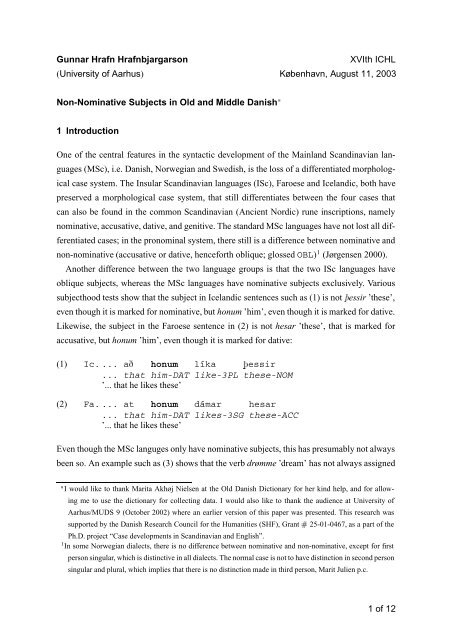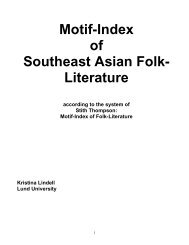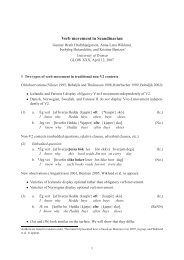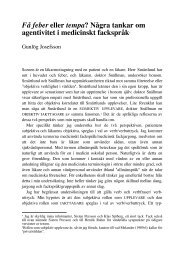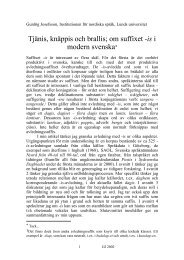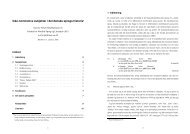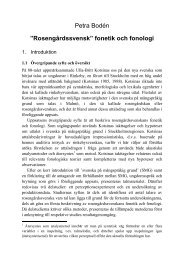Non-Nominative Subjects in Old and Middle Danish
Non-Nominative Subjects in Old and Middle Danish
Non-Nominative Subjects in Old and Middle Danish
Create successful ePaper yourself
Turn your PDF publications into a flip-book with our unique Google optimized e-Paper software.
Gunnar Hrafn Hrafnbjargarson<br />
XVIth ICHL<br />
(University of Aarhus) København, August 11, 2003<br />
<strong>Non</strong>-<strong>Nom<strong>in</strong>ative</strong> <strong>Subjects</strong> <strong>in</strong> <strong>Old</strong> <strong>and</strong> <strong>Middle</strong> <strong>Danish</strong> £<br />
1 Introduction<br />
One of the central features <strong>in</strong> the syntactic development of the Ma<strong>in</strong>l<strong>and</strong> Sc<strong>and</strong><strong>in</strong>avian languages<br />
(MSc), i.e. <strong>Danish</strong>, Norwegian <strong>and</strong> Swedish, is the loss of a differentiated morphological<br />
case system. The Insular Sc<strong>and</strong><strong>in</strong>avian languages (ISc), Faroese <strong>and</strong> Icel<strong>and</strong>ic, both have<br />
preserved a morphological case system, that still differentiates between the four cases that<br />
can also be found <strong>in</strong> the common Sc<strong>and</strong><strong>in</strong>avian (Ancient Nordic) rune <strong>in</strong>scriptions, namely<br />
nom<strong>in</strong>ative, accusative, dative, <strong>and</strong> genitive. The st<strong>and</strong>ard MSc languages have not lost all differentiated<br />
cases; <strong>in</strong> the pronom<strong>in</strong>al system, there still is a difference between nom<strong>in</strong>ative <strong>and</strong><br />
non-nom<strong>in</strong>ative (accusative or dative, henceforth oblique; glossed OBL) 1 (Jørgensen 2000).<br />
Another difference between the two language groups is that the two ISc languages have<br />
oblique subjects, whereas the MSc languages have nom<strong>in</strong>ative subjects exclusively. Various<br />
subjecthood tests show that the subject <strong>in</strong> Icel<strong>and</strong>ic sentences such as (1) is not essir ’these’,<br />
even though it is marked for nom<strong>in</strong>ative, but honum ’him’, even though it is marked for dative.<br />
Likewise, the subject <strong>in</strong> the Faroese sentence <strong>in</strong> (2) is not hesar ’these’, that is marked for<br />
accusative, but honum ’him’, even though it is marked for dative:<br />
(1) Ic. ... a honum líka essir<br />
... that him-DAT like-3PL these-NOM<br />
’... that he likes these’<br />
(2) Fa. ... at honum dámar hesar<br />
... that him-DAT likes-3SG these-ACC<br />
’... that he likes these’<br />
Even though the MSc languges only have nom<strong>in</strong>ative subjects, this has presumably not always<br />
been so. An example such as (3) shows that the verb drømme ’dream’ has not always assigned<br />
£ I would like to thank Marita Akhøj Nielsen at the <strong>Old</strong> <strong>Danish</strong> Dictionary for her k<strong>in</strong>d help, <strong>and</strong> for allow<strong>in</strong>g<br />
me to use the dictionary for collect<strong>in</strong>g data. I would also like to thank the audience at University of<br />
Aarhus/MUDS 9 (October 2002) where an earlier version of this paper was presented. This research was<br />
supported by the <strong>Danish</strong> Research Council for the Humanities (SHF), Grant 25-01-0467, as a part of the<br />
Ph.D. project “Case developments <strong>in</strong> Sc<strong>and</strong><strong>in</strong>avian <strong>and</strong> English”.<br />
1 In some Norwegian dialects, there is no difference between nom<strong>in</strong>ative <strong>and</strong> non-nom<strong>in</strong>ative, except for first<br />
person s<strong>in</strong>gular, which is dist<strong>in</strong>ctive <strong>in</strong> all dialects. The normal case is not to have dist<strong>in</strong>ction <strong>in</strong> second person<br />
s<strong>in</strong>gular <strong>and</strong> plural, which implies that there is no dist<strong>in</strong>ction made <strong>in</strong> third person, Marit Julien p.c.<br />
1of12
G. Hr. Hrafnbjargarson XVIth International Conference on Historical L<strong>in</strong>guistics<br />
nom<strong>in</strong>ative case to its subject <strong>in</strong> <strong>Danish</strong>:<br />
(3) OD. Drømde mik en drøm i nat ...<br />
Dreamt me-OBL a dream <strong>in</strong> night<br />
’I dreamt a dream tonight ...’ (1300, RUNEV, Brøndum-Nielsen 1932:14)<br />
To show that <strong>Old</strong> <strong>Danish</strong> (OD) <strong>and</strong> <strong>Middle</strong> <strong>Danish</strong> (MD) did have oblique subjects, I will<br />
make use of the subjecthood tests that have been used to argue for the existence of oblique<br />
subjects <strong>in</strong> Icel<strong>and</strong>ic <strong>and</strong> Faroese (cf. Andrews 1976, Thrá<strong>in</strong>sson 1979, <strong>and</strong> Sigursson 1989),<br />
on data I have collected at the <strong>Old</strong> <strong>Danish</strong> Dictionary. The examples I have collected <strong>in</strong>clude<br />
the verbs behage ’please’ drøme ’dream’, dughe ’be fit’ gaghne ’be useful’ græmje ’grieve’,<br />
like ’like’, lithe ’suffer’, sjune ’seem’ <strong>and</strong> thykje ’th<strong>in</strong>k / seem’.<br />
I collected 139 examples from the period 1200-1515 where either the subject, or the object,<br />
or both the subject <strong>and</strong> the object are pronouns. Not all of the subjecthood tests can be used<br />
for <strong>Danish</strong> but the tests that can be used, e.g. subject position <strong>and</strong> reflexivization show that the<br />
majority of the examples (107 of 139, 77%) have oblique subjects.<br />
Around the year 1450, the probability of f<strong>in</strong>d<strong>in</strong>g sentences (with the n<strong>in</strong>e verbs mentioned<br />
above) with oblique subjects becomes less than the probability of f<strong>in</strong>d<strong>in</strong>g sentences with a<br />
nom<strong>in</strong>ative subject <strong>and</strong> an accusative object.<br />
2 Subjecthood tests<br />
There are various ways of test<strong>in</strong>g subjecthood. <strong>Subjects</strong> have special positions <strong>in</strong> embedded<br />
clauses, reflexive pronouns can only be bound by subjects <strong>and</strong> subjects have a special position<br />
<strong>in</strong> ECM constructions. An <strong>in</strong>f<strong>in</strong>itive cannot check case on its subject, <strong>in</strong>stead, the matrix verb<br />
assigs <strong>and</strong> checks oblique case on the subject <strong>in</strong> the embedded clause (for example: She saw<br />
[me read the book]). There are eight subjecthood tests (for a more detailed discussion <strong>and</strong> a<br />
slightly different division of the tests, see Thrá<strong>in</strong>sson 1979, Sigursson 1989:204-209, Rögnvaldsson<br />
1996, <strong>and</strong> Bardal 2000):<br />
1. Position 4. ECM 7. Control<br />
2. Reflexivization 5. Rais<strong>in</strong>g 8. Cliticization<br />
3. Conjunction Reduction 6. Heavy Subject Shift<br />
Some of the eight tests are rather difficult to carry out, as for <strong>in</strong>stance ECM construction,<br />
because it is rare to have a verb that assigns oblique case to its subject embedded under verbs<br />
like se ’see’, høre ’hear’, føle ’feel’, bede ’ask’, <strong>and</strong> lade ’let’. A test like Heavy Subject Shift<br />
København, August 11, 2003 2 of 12
G. Hr. Hrafnbjargarson XVIth International Conference on Historical L<strong>in</strong>guistics<br />
is also hard to carry out because differences <strong>in</strong> case can only be found with<strong>in</strong> the pronom<strong>in</strong>al<br />
system <strong>and</strong> pronouns are not “heavy” enough to undergo this type of movement.<br />
For the Germanic languages, control, conjuntion reduction <strong>and</strong> reflexivization are considered<br />
to be the ma<strong>in</strong> subject properties (Eythórsson & Bardal 2003:147 <strong>and</strong> references there).<br />
2.1 Position<br />
<strong>Subjects</strong> have a specific position <strong>in</strong> the clause. In the unmarked case, where a subject has been<br />
topicalized, it is positioned immediately before the f<strong>in</strong>ite verb, i.e. CP-Spec: 2<br />
(4) MD. Meg synes eij blomster lystelig<br />
Me-OBL seems-SG not flowers beautiful<br />
’I do not th<strong>in</strong>k that flowers are beautiful’ (1509, FLOR.1321)<br />
(5) Da. Jeg har måske læst bogen<br />
I-NOM have maybe read book-the<br />
’I have maybe read the book’<br />
If the subject is not topicalized, its usual position is the position immediately after the f<strong>in</strong>ite<br />
verb, i.e. IP-Spec. In (6a) <strong>and</strong> (7a), an adverbial has been topicalized, (6b) <strong>and</strong> (7b) are examples<br />
of <strong>in</strong>version <strong>in</strong> a yes/no question <strong>and</strong> (6c) is a V1-declarative: 3<br />
(6) MD. a. thij synthes meg thet ynkelicke<br />
therefore thought-SG me-OBL it miserable<br />
’Therefore, I thought it was miserable’ (1509, FLOR.v1404)<br />
b. synes thek ey so at være<br />
th<strong>in</strong>ks-SG you-OBL not such to be<br />
’Do you not th<strong>in</strong>k that it is such’<br />
(1500, SUSO)<br />
c. syntis honum som the komo til et<br />
thought-SG him-OBL as they-NOM came-3PL to a<br />
stort<br />
big<br />
vatn<br />
lake<br />
’He thought that they had come to a big lake’<br />
(1425, SJTR)<br />
(7) Da. a. Derfor har jeg læst<br />
Therefore have I-NOM read<br />
’Therefore, I have read the book’<br />
b. Har du ikke læst<br />
Have you-NOM not read<br />
’Haven’t you read the book’<br />
bogen<br />
book-the<br />
bogen<br />
book-the<br />
In embedded clauses, the subject immediately follows the complementizer:<br />
2 Like Modern <strong>Danish</strong>, <strong>Old</strong> <strong>and</strong> <strong>Middle</strong> <strong>Danish</strong> were V2 languages.<br />
3 V1-declaratives are not possible <strong>in</strong> Modern <strong>Danish</strong>.<br />
København, August 11, 2003 3 of 12
G. Hr. Hrafnbjargarson XVIth International Conference on Historical L<strong>in</strong>guistics<br />
(8) OD. um them thickir swa<br />
if they-OBL th<strong>in</strong>ks-3SG such<br />
’if they th<strong>in</strong>k such’<br />
(9) MD. tho at thek synes annær ledhes<br />
though that you-OBL th<strong>in</strong>k-SG other wise<br />
’Though you th<strong>in</strong>k it is otherwise’<br />
(1200, SKLOV)<br />
(1450, SØNDEV)<br />
(10) Da. a. ... hvis de ikke<br />
... if they-NOM not<br />
’... if they have not read the book’<br />
b. ... selvom du aldrig har<br />
... though you-NOM never have<br />
’... though you have never read the book’<br />
har læst bogen<br />
have read book-the<br />
læst bogen<br />
read book-the<br />
I found no examples of topicalization of objects <strong>in</strong> embedded clauses with verbs that assign<br />
oblique case to their subjects, i.e. the word order complementizer – object – verb Ò – subject<br />
– verb ÑÒ :<br />
(11) a. *om det<br />
if it<br />
b. *...<br />
...<br />
havde<br />
had<br />
dig syntes<br />
you thought<br />
selvom bogen havde<br />
though book-the had<br />
du læst<br />
you read<br />
Examples such as (8) are relevant because if them ’them’ <strong>in</strong> (8) were an object follow<strong>in</strong>g a<br />
complementizer, then examples such as (11a) should also exist.<br />
2.2 Reflexivization<br />
In modern Sc<strong>and</strong><strong>in</strong>avian (MSc <strong>and</strong> ISc), reflexive pronouns can only be bound by subjects:<br />
(12) Da. a. Hun i fortalte<br />
She-NOM told<br />
ham j en<br />
him-OBL a<br />
selv i/*j<br />
SELF<br />
’She told him a story about herself’<br />
b. Han i gik sig i en tur<br />
He-NOM walked REFL a tour<br />
’He took himself a stroll on the beach’<br />
historie<br />
story<br />
på str<strong>and</strong>en<br />
on beach-the<br />
om sig<br />
about REFL<br />
Accord<strong>in</strong>g to Mikkelsen (1911:258-267), this also holds for the older stages of <strong>Danish</strong>. Therefore,<br />
honum ’him’ <strong>in</strong> (13) must be the subject:<br />
København, August 11, 2003 4 of 12
G. Hr. Hrafnbjargarson XVIth International Conference on Historical L<strong>in</strong>guistics<br />
(13) MD. Honum thøkte [ sek vara i en<br />
Him-DAT thought REFL be <strong>in</strong> a<br />
’He thought that he was <strong>in</strong> a wonderful town’<br />
lysteligen<br />
wonderful<br />
stath ]<br />
town<br />
(1425, SJTR)<br />
2.3 Conjunction Reduction<br />
In modern Sc<strong>and</strong><strong>in</strong>avian (MSc <strong>and</strong> ISc), the subject <strong>in</strong> the last of two conjo<strong>in</strong>ed sentences can<br />
be omitted. In such context, the object cannot be omitted:<br />
(14) Da. a. I dag læste<br />
Today read<br />
jeg en<br />
I-NOM a<br />
brev<br />
letter<br />
’Today, I read a book <strong>and</strong> wrote a letter’<br />
bog og [e] skrev et<br />
book <strong>and</strong> wrote a<br />
b. *Denne bog f<strong>and</strong>t jeg og [e] købte jeg med<br />
This book found I-NOM <strong>and</strong> bought I-NOM with<br />
det samme<br />
the same<br />
If <strong>Old</strong> <strong>and</strong> <strong>Middle</strong> <strong>Danish</strong> behaved <strong>in</strong> the same way as Modern <strong>Danish</strong>, i.e. that only subjects<br />
can be omitted, oss ’us’ <strong>in</strong> (15) must be the subject for both lighe ’like’ <strong>and</strong> noghe ’be content<br />
with’: 4<br />
(15) MD. ... ladæ [ oss lighe ok [e] noghæ meth thet ]<br />
... let us-OBL like <strong>and</strong> be content with it<br />
’... let us like it <strong>and</strong> be content with it’ (1407) 5<br />
This example is however not completely unproblematic. First of all, it is <strong>in</strong>convenient<br />
that the subjects of both conjo<strong>in</strong>ed clauses are oblique subjects. It is known from German<br />
(cf. Eythórsson & Bardal 2003:174 <strong>and</strong> references there) that subject-like datives <strong>and</strong> accusatives<br />
can be omitted <strong>in</strong> the last of two conjo<strong>in</strong>ed sentences if there is a subject-like dative<br />
or accusative <strong>in</strong> the first of two conjo<strong>in</strong>ed sentences. Accord<strong>in</strong>g to Eythórsson & Bardal<br />
(2003:175) the same holds for nom<strong>in</strong>ative subjects <strong>in</strong> German, i.e. nom<strong>in</strong>ative subjects can<br />
only be omitted if the subject of the first clause is nom<strong>in</strong>ative. Eythórsson & Bardal (2003)<br />
take this fact not to weaken Conjunction Reduction as a subjecthood test, rather they take it to<br />
proove the existance of oblique subjects <strong>in</strong> German.<br />
4 The verb nøjes ’be content with’ also assigned oblique case to its subject:<br />
(i)<br />
Da. Hun har alt det, mig k<strong>and</strong> nøje<br />
She has all that me-OBL can be content with<br />
’She has everyth<strong>in</strong>g that I can be content with’<br />
(1648, ASC I.178)<br />
5 26/2 1407 (Rosk,Rep.4882;i vid, 25/5 1414 kanc.).(bisp el.)kanc.;<br />
København, August 11, 2003 5 of 12
G. Hr. Hrafnbjargarson XVIth International Conference on Historical L<strong>in</strong>guistics<br />
The second <strong>in</strong>convenience about example (15) is that the verb lade ’let’, which is an ECM<br />
verb, allows for topicalization of the object. This will become clear <strong>in</strong> the next section.<br />
2.4 ECM constructions<br />
In ECM constructions, the subject position is the first position of the embedded clause. The<br />
verb <strong>in</strong> the embedded clause is an <strong>in</strong>f<strong>in</strong>itive <strong>and</strong> it cannot check case on the subject of the<br />
clause. Therefore, the matrix verb (usually a perception verb such as se ’see’, høre ’hear, bede<br />
’ask’, føle ’feel’ or lade ’let’) checks case on the subject.<br />
I found no examples of oblique case assign<strong>in</strong>g verbs <strong>in</strong> ECM constructions but such examples<br />
can be found: 6<br />
(16) MD. ... och lodh sigh møghit tycke atwære cloogh<br />
... <strong>and</strong> let REFL-OBL much th<strong>in</strong>k to be clever<br />
vdi loghen<br />
about law-the<br />
(1450-1500, Mirakel om Biskop Dunstanus)<br />
’... <strong>and</strong> let himself make the impression as if he knew much about the law’<br />
This test might however not be suitable for <strong>Danish</strong>. As mentioned above, one of the ECM<br />
verbs, the verb lade ’let’, allows the object to be topicalized:<br />
(17) MD. oc lada honum cristna af pafvan<br />
<strong>and</strong> let him-OBL Christianize of pope<br />
’<strong>and</strong> let him be Christianized by the pope himself’<br />
sælfom<br />
self<br />
(1425, SJTR)<br />
2.5 Rais<strong>in</strong>g<br />
In rais<strong>in</strong>g, the subject of the embedded clause raises to the subject position of the matrix clause.<br />
Usually, the subject is assigned nom<strong>in</strong>ative case by the matrix verb but <strong>in</strong>herent oblique case<br />
(potentially assigned by the <strong>in</strong>f<strong>in</strong>itive) overrides nom<strong>in</strong>ative case assignment <strong>and</strong> the <strong>in</strong>herent<br />
case surfaces <strong>in</strong> the matrix clause.<br />
I found no cases of rais<strong>in</strong>g with oblique case assign<strong>in</strong>g verbs <strong>in</strong> the <strong>Old</strong> <strong>Danish</strong> Dictionary<br />
but cases of rais<strong>in</strong>g have been cited <strong>in</strong> the literature (Bardal 2000:37). Bardal’s (2000:37)<br />
three examples from <strong>Middle</strong> <strong>Danish</strong> all <strong>in</strong>clude modal verbs. She cites two examples with the<br />
modal kunne ’can’, <strong>and</strong> one with the modal må ’may’, shown <strong>in</strong> (18), Bardal (2000:37, (24)):<br />
(18) MD. them i motthæ [ t i ther foræ grwæ ]<br />
them.OBL might that for disgust<br />
’They should be disgusted by that’ (1450, Rimkrønikken, Nielsen 1895-1911:71)<br />
6 Example (16) is cited <strong>in</strong> Bardal (2000:35, (16)), who cites Diderichsen (1931-1937:170). Here, it is <strong>in</strong> my<br />
translation.<br />
København, August 11, 2003 6 of 12
G. Hr. Hrafnbjargarson XVIth International Conference on Historical L<strong>in</strong>guistics<br />
In the <strong>Old</strong> <strong>Danish</strong> Dictionary, I found three such examples, one with the modal skulle ’shall’<br />
<strong>and</strong> two with the modal må ’may’.<br />
This depends on the assumption that modals are rais<strong>in</strong>g verbs. It would be less controversial<br />
if the example had the verb forekomme ’seem’ <strong>in</strong>stead of the modal. I have however not found<br />
any such examples.<br />
2.6 Heavy Subject Shift<br />
In modern <strong>Danish</strong>, heavy pronom<strong>in</strong>als that behave like full DPs can be found, for example<br />
du og jeg ’you <strong>and</strong> I’ or ham med den grimme Volvo ’him with the ugly Volvo’ but they do<br />
not necessarily have to undergo Heavy Subject Shift (Jørgensen 2000:72-76, <strong>and</strong> Mikkelsen<br />
1911:593-596). 7<br />
(19) Da. a. *Da kørte lige <strong>in</strong>d i tankstationen ham<br />
Then drove right <strong>in</strong> <strong>in</strong> petrol station-the him<br />
med den grimme Volvo<br />
with the ugly Volvo<br />
b. Da kørte ham med den grimme Volvo lige<br />
Then drove him-OBL with the ugly Volvo right<br />
<strong>in</strong>d i tankstationen<br />
<strong>in</strong> <strong>in</strong> petrol station-the<br />
’Then, the one with the ugly Volvo crashed right <strong>in</strong>to the petrol-station’<br />
Because I only collected examples with pronom<strong>in</strong>als, I found no examples with oblique case<br />
assign<strong>in</strong>g verbs that show Heavy Subject Shift <strong>in</strong> the <strong>Old</strong> <strong>Danish</strong> Dictionary. I have not found<br />
examples of Heavy Subject Shift <strong>in</strong> the corpus Dansk Sprog- og Stilhistorisk Database (Ruus<br />
2001) either.<br />
Furthermore, the status of Heavy Subject Shift as a subjecthood test for <strong>Danish</strong> is not clear,<br />
cf. that e.g. Vikner (1995:206) considers Heavy Subject Shift to be ungrammatical <strong>in</strong> <strong>Danish</strong>,<br />
even with heavy NP subjects.<br />
2.7 Control<br />
Control <strong>in</strong>f<strong>in</strong>itives are embedded <strong>in</strong>f<strong>in</strong>itival clauses where the subject has been omitted. They<br />
are called control <strong>in</strong>f<strong>in</strong>itives because the subject of the matrix clause controls, <strong>and</strong> allows for<br />
the omission of the subject <strong>in</strong> the embedded clause. In the Modern <strong>Danish</strong> sentence <strong>in</strong> (20),<br />
the subject han ’he’ controls the subject gap <strong>in</strong> the embedded clause. The subject gap is filled<br />
7 Ken Ramshøj Christensen, p.c., has told me that (19a) is very archaic, if not ungrammatical, <strong>and</strong> that most<br />
people would prefer (19b) over (19a).<br />
København, August 11, 2003 7 of 12
G. Hr. Hrafnbjargarson XVIth International Conference on Historical L<strong>in</strong>guistics<br />
with PRO. PRO can only be controlled by a subject, <strong>and</strong> PRO is always coreferent with the<br />
subject <strong>in</strong> the matrix clause:<br />
(20) Da. Han i håber [ at PRO i behage s<strong>in</strong> svigermor ]<br />
He-NOM hopes to please POSS mother-<strong>in</strong>-law<br />
’He hopes to please his mother-<strong>in</strong>-law’<br />
Sigursson (1989:207) shows that PRO is case marked <strong>in</strong> Icel<strong>and</strong>ic. PRO can show up with<br />
both verbs that assign nom<strong>in</strong>ative to their subject as well as verbs that assign dative <strong>and</strong> accusative<br />
to their subjects. I found no examples of control <strong>in</strong>f<strong>in</strong>itives <strong>in</strong> the <strong>Old</strong> <strong>Danish</strong> Dictionary,<br />
but I have found examples <strong>in</strong> Dansk Sprog- og Stilhistorisk Database (Ruus 2001). The<br />
verb bør ’ought’, which embeds a control <strong>in</strong>f<strong>in</strong>itive, used to assign an oblique case to its subject.<br />
In (21a), PRO is controlled by the oblique thek ’you’ <strong>and</strong> <strong>in</strong> (21b), PRO is controlled by<br />
the oblique teg ’you’. Both holde ’keep’ <strong>and</strong> gøre ’do’ assign nom<strong>in</strong>ative case to their subject:<br />
(21) MD. a. thæn edh<strong>in</strong> bør thek i <strong>in</strong>gelund [ at PRO i<br />
that oath ought you-OBL <strong>in</strong> no way to NOM<br />
halda ]<br />
keep<br />
’You ought not keep this oath <strong>in</strong> any way’<br />
(1425, SJTR)<br />
b. men tenck thu huad teg i bør [ att PRO i gøre ]<br />
but th<strong>in</strong>k you what you-OBL ought to NOM do<br />
’But th<strong>in</strong>k what you ought to do’ (1534, En kristen Fyrstis Lære)<br />
Likewise, PRO could show up <strong>in</strong> control <strong>in</strong>f<strong>in</strong>itives with oblique case assign<strong>in</strong>g verbs. The<br />
verbs undre ’be surprised’ <strong>and</strong> lide ’like’ had oblique subjects <strong>in</strong> <strong>Old</strong> <strong>and</strong> <strong>Middle</strong> <strong>Danish</strong>.<br />
Note that <strong>in</strong> (22b), Christum ’Christ’ is marked for dative (cf. also section 2.5):<br />
(22) MD. a. Men [ een god furste ] i bør icke att PRO i<br />
But a good pr<strong>in</strong>ce ought not to OBL<br />
wndre paa the th<strong>in</strong>g<br />
surprise over those t<strong>in</strong>gs (1534, En kristen Fyrstis Lære)<br />
’But a good pr<strong>in</strong>ce ought not to be surprised over those th<strong>in</strong>gs’<br />
b. Burde det ikke Christum i [ at PRO i lide det ] ...<br />
Ought it not Christ-DAT to OBL like it ...<br />
’Ought Christ not like it ...’ (1638, Jesper Brochm<strong>and</strong>s Huus-Postill)<br />
2.8 Cliticization<br />
Accord<strong>in</strong>g to Brøndum-Nielsen (1965:48), clitics are “especially common <strong>in</strong> accusative <strong>and</strong><br />
show up <strong>in</strong> texts that are affected by the spoken language” (my translation). In <strong>Old</strong> <strong>Danish</strong>,<br />
han ’him-ACC’ had the clitic form -an/-æn, or-n <strong>and</strong> hana ’she-ACC’ had the clitic form<br />
København, August 11, 2003 8 of 12
G. Hr. Hrafnbjargarson XVIth International Conference on Historical L<strong>in</strong>guistics<br />
-ana/-(æ)na. I found no examples of cliticization. The reason might be that the clitics have<br />
been replaced by full pronouns <strong>in</strong> later versions of the same text (Brøndum-Nielsen 1965:48).<br />
3 Summary<br />
In Icel<strong>and</strong>ic, oblique subjects pass all the eight subjecthood tests. In <strong>Old</strong> <strong>and</strong> <strong>Middle</strong> <strong>Danish</strong>,<br />
oblique subjects pass subjecthood tests like position, reflexivization, conjunction reduction,<br />
rais<strong>in</strong>g, <strong>and</strong> control. In <strong>Old</strong> <strong>and</strong> <strong>Middle</strong> <strong>Danish</strong>, oblique subjects show up <strong>in</strong> the same positions<br />
as nom<strong>in</strong>ative subjects <strong>in</strong> matrix clauses, embedded clauses <strong>and</strong> <strong>in</strong> sentences where someth<strong>in</strong>g<br />
else than the subject has been topicalized.<br />
With respect to reflexivization <strong>and</strong> conjunction reduction, oblique subjects behave <strong>in</strong> the<br />
same way as nom<strong>in</strong>ative subjects <strong>in</strong> <strong>Old</strong> <strong>and</strong> <strong>Middle</strong> <strong>Danish</strong>. Reflexive pronouns could be<br />
bound by oblique subjects <strong>and</strong> it was possible to omit an oblique subject <strong>in</strong> the last of two<br />
conjo<strong>in</strong>ed sentences.<br />
Examples of rais<strong>in</strong>g can also be found <strong>in</strong> <strong>Old</strong> <strong>and</strong> <strong>Middle</strong> <strong>Danish</strong>. In all examples the matrix<br />
verb is a modal verb <strong>and</strong> <strong>in</strong> all cases the subject preserves the oblique case assigned to it by<br />
the <strong>in</strong>f<strong>in</strong>itive <strong>in</strong> the embedded clause. Control <strong>in</strong>f<strong>in</strong>itives with oblique subjects also existed <strong>in</strong><br />
<strong>Old</strong> <strong>and</strong> <strong>Middle</strong> <strong>Danish</strong>. As I have shown, oblique case marked PRO could be controlled by<br />
a nom<strong>in</strong>ative subject <strong>and</strong> a PRO marked for nom<strong>in</strong>ative could be controlled by an oblique<br />
subject.<br />
I have not found any examples of cliticization of oblique subjects <strong>in</strong> <strong>Old</strong> <strong>and</strong> <strong>Middle</strong> <strong>Danish</strong>.<br />
Like <strong>in</strong> Modern <strong>Danish</strong>, only pronouns were marked for morphological case <strong>in</strong> <strong>Old</strong> <strong>and</strong> <strong>Middle</strong><br />
<strong>Danish</strong>. I have not found examples of Heavy Subject Shift <strong>in</strong> <strong>Old</strong> <strong>and</strong> <strong>Middle</strong> <strong>Danish</strong> but this<br />
test might not be suitable as a subjecthood test for <strong>Danish</strong>.<br />
Another test, ECM construction, is also not suitable for <strong>Danish</strong>. At least one of the ECM<br />
verbs, lade ’let’, allows for topicalization of the object.<br />
København, August 11, 2003 9 of 12
G. Hr. Hrafnbjargarson XVIth International Conference on Historical L<strong>in</strong>guistics<br />
4 Conclusion<br />
I have shown that <strong>Old</strong> <strong>and</strong> <strong>Middle</strong> <strong>Danish</strong> had oblique subjects. This conclusion is drawn from<br />
the fact that oblique subjects <strong>in</strong> <strong>Old</strong> <strong>and</strong> <strong>Middle</strong> <strong>Danish</strong> pass five of the eight subjecthood<br />
tests, position, reflexivization, conjunction reduction, rais<strong>in</strong>g, <strong>and</strong> control. Three of the tests<br />
that oblique subjects <strong>in</strong> <strong>Old</strong> <strong>and</strong> <strong>Middle</strong> <strong>Danish</strong> pass, are the tests that are considered to be the<br />
ma<strong>in</strong> properties of subjects <strong>in</strong> the Germanic languages, namely reflexivization, conjunction<br />
reduction, <strong>and</strong> control.<br />
Texts used<br />
OLD DANISH DICTIONARY<br />
ASC Astree Siunge-Choer. Dated 1648.<br />
FLOR Flores og Blanseflor, Ghemen-tryk. Dated 1509.<br />
SJTR Sjælens Trøst. Cod.Ups. C 529, Cod.Holm. A 109. Dated ca. 1425.<br />
SKLOV Skånske lov. Cod.Holm B 74. Dated ca. 1200.<br />
SUSO Henrik Susos Gudelig Visdoms Bog, AM783,4 Dated 1500.<br />
SØNDEV Tillæg til Søndags-Evangelier, GkS1390,4. Dated 1450<br />
Examples (21) <strong>and</strong> (22) are taken from Ruus (2001).<br />
Additional <strong>in</strong>formation on manuscripts, editions, <strong>and</strong> published versions of the texts is available<br />
onl<strong>in</strong>e at the <strong>Old</strong> <strong>Danish</strong> Dictionary web pages (http://www.dsl.dk/go_kildeliste.html).<br />
København, August 11, 2003 10 of 12
G. Hr. Hrafnbjargarson XVIth International Conference on Historical L<strong>in</strong>guistics<br />
References<br />
Andrews, Avery (1976): The VP Complement Analysis <strong>in</strong> Modern Icel<strong>and</strong>ic. In: Proceed<strong>in</strong>gs<br />
of NELS 6. pp. 1–21.<br />
Bardal, Jóhanna (2000): “Oblique <strong>Subjects</strong> <strong>in</strong> <strong>Old</strong> Sc<strong>and</strong><strong>in</strong>avian”, North-Western European<br />
Language Evolution 37, 25–51.<br />
Brøndum-Nielsen, Johannes (1965): Gammeldansk Grammatik. Vol. V, Akademisk Forlag,<br />
København.<br />
Brøndum-Nielsen, Johannes, ed. (1932): Danske Sprogtekster til Universitetsbrug. Vol. I, 2<br />
edn, J. H. Schultz forlag, København.<br />
Diderichsen, Paul, ed. (1931-1937): Fragmenter af gammeldanske Håndskrifter. J. H. Schultz<br />
Forlag.<br />
Eythórsson, Thórhallur & Jóhanna Bardal (2003): “Oblique <strong>Subjects</strong>: A Germanic Inheritance!”,<br />
Work<strong>in</strong>g Papers <strong>in</strong> Sc<strong>and</strong><strong>in</strong>avian Syntax 71, 145–202.<br />
Jørgensen, Henrik (2000): Studien zur Morphologie und Syntax der festl<strong>and</strong>sk<strong>and</strong><strong>in</strong>avischen<br />
Personalpronom<strong>in</strong>a. Aarhus University Press, Århus.<br />
Mikkelsen, Kristian (1911): Dansk Ordföjn<strong>in</strong>gslære. Lehman & Stage, København. Republished<br />
1975 by Hans Reitzels Forlag, København.<br />
Nielsen, Holger, ed. (1895-1911): Den danske Rimkrønike. H. H. Thieles Boktrykkeri.<br />
Rögnvaldsson, Eiríkur (1996): “Frumlag og fall a fornu”, Íslenskt mál og almenn málfræi<br />
18, 37–69.<br />
Ruus, Hanne, ed. (2001): Dansk Sprog- og Stilhistorisk Database. CD-ROM published by the<br />
Department of Nordic Philology, University of Copenhagen.<br />
Sigursson, Halldór Ármann (1989): Verbal Syntax <strong>and</strong> Case <strong>in</strong> Icel<strong>and</strong>ic. PhD thesis, Lund<br />
University.<br />
Thrá<strong>in</strong>sson, Höskuldur (1979): On Complementation <strong>in</strong> Icel<strong>and</strong>ic. Garl<strong>and</strong> Publish<strong>in</strong>g, New<br />
York.<br />
Vikner, Sten (1995): Verb Movement <strong>and</strong> Expletive <strong>Subjects</strong> <strong>in</strong> the Germanic Languages. Oxford<br />
University Press, New York.<br />
København, August 11, 2003 11 of 12
Gunnar Hrafn Hrafnbjargarson<br />
Aarhus Universitet<br />
Institut for Nordisk Sprog og Litteratur<br />
DK–8000 Århus C<br />
Denmark<br />
norhrafn@hum.au.dk<br />
http://www.hum.au.dk/nordisk/norhrafn/<strong>in</strong>dex_en.htm<br />
12 of 12


